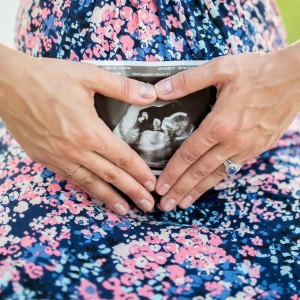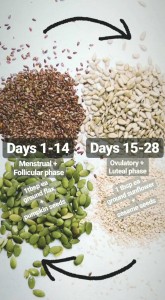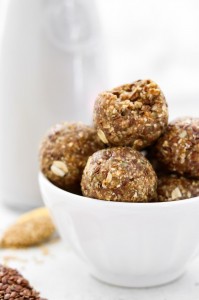Getting pregnant with my daughter was nothing short of a miracle. In addition to undergoing multiple rounds of In Vitro-Fertilization, it also required a complete overhaul of my lifestyle: from diet and exercise (body and mind) to incorporating several medicinal and holistic protocols. While I was already eating a balanced diet and working out regularly, I may not have been doing so in ways that supported optimal health and fertility. Case in point, yoga – while great for you – is not ideal in an overly heated environment (as it creates some complications with a number of IVF medications); similarly, vegetables – while also great – are best when cooked (the rationale being cold or raw foods require extra energy to digest, which draws energy away from the other organ systems). 
Simply knowing your body and taking care of yourself can make a remarkable difference in how long it takes to conceive. I’ll be the first to admit, I didn’t know much we first attempted to become parents, but years of infertility and countless doctor visits was educational in more ways than one. So, with my copious notes on what worked (and what didn’t) in hand, one of my goals in seeking treatment from The Wellness Path was to get pregnant (again), only this time naturally!
Spoiler Alert: I am NOT pregnant. But I plan on doing everything in my control to boost fertility, while balancing my hormones (since hormones have a profound effect on our mental, physical and emotional health). I have no idea if this will work… but worst-case scenario: even I don’t get pregnant; I still foster a healthy lifestyle for myself.
Causes of Hormonal Imbalance
Most women produce adequate levels of hormones to support a healthy menstrual cycle. However, certain health conditions, such as PCOS and hypothyroidism, as well as over-exercising and being under- or overweight, can lead to a hormonal imbalance. Despite the fact that aging and other factors are beyond our control, there are steps we can take to improve our hormonal health. In particular, seed cycling is a naturopathic remedy that aims to balance estrogen and progesterone levels, not only supporting those with hormonal imbalances but also those with healthy cycles.
Cynics will state that there is not enough proof that seed cycling helps with conception. But eating seeds is a gamble I’m more than willing to take (and I’m pretty certain that most women aren’t willing to wait around 10 years to find out if was all just a harmless placebo anyway… am I right)? So while seed cycling may not be 100% evidence-based (although there is some science, which I will share), there is very little (if any) risk. In essence, all you do is eat fertility-friendly food timed with your menstrual cycle. I did about 50+ things to get (and stay) pregnant, so really – what’s one more thing?
The Four Phases of Your Cycle 1. menstrual 2. follicular 3. ovulatory 4. luteal
During the menstrual and follicular phase, your body needs support producing and metabolizing estrogen. Seed cycling is one way to help nudge your hormones in the right direction! Additionally having a proper balance of estrogen to progesterone is key to prevent symptoms like painful periods, irregular periods, acne, and more.
Keep in mind, a healthy cycle will vary in length, but somewhere between 25-35 days is optimal.
How Does Seed Cycling Work (and the Seeds Involved) 
Essentially, through the lignans, minerals, vitamins, and phytoestrogens found in certain seeds, your body’s endocrine and detoxification systems are supported (which in turns helps to balance your hormones).
Days 1-14 (the first day of your period through ovulation): eat 1 tbsp. daily of both flax and pumpkin seeds to support estrogen production and metabolism • FLAX & PUMPKIN – contain lignans, which helps bind excess estrogen, so that it can be eliminated from the body and prevent estrogen dominance.
Days 15-28: eat 1 tbsp. daily of both sesame and sunflower seeds to boost progesterone production, metabolism and successful implantation of a healthy embryo
• SUNFLOWER & SESAME – are high in selenium and vitamin E, which are known to stimulate progesterone production.
Note: If you know you ovulate on day 17 of your cycle and not day 14 (for example), you would adjust the days of cycling so that you switch to the sesame and sunflower phase right after you ovulate (whenever that day is for your menstrual cycle).
How Seeds Influence Hormones (now for the Science)
• Flax Seeds – are high in calcium and Omega 3 fatty acids, has been shown to reduce anovulatory cycles and help lengthen luteal phases by regulating FSH levels. The phytoestrogens in flax can help increase or decrease estrogen levels as needed. Phytoestrogens are compounds in plants that mimic the action of estrogen to grow healthy eggs (a far more natural method than the IVF medication I became accustomed to taking leading up to Egg Retrievals).
• Pumpkin Seeds – are high in minerals needed for hormone balance, such as manganese, magnesium, and zinc. They are high in isoflavones and have been shown to boost healthy estradiol levels and moderating estrogen receptors to protect the body from bad estrogens. Additionally, zinc from pumpkin seeds is claimed to promote progesterone production in preparation for the next phase of the cycle.
• Sunflower Seeds – are high in magnesium and B6. The vitamin E in sunflower is also said to help boost progesterone levels.
• Sesame Seeds – are high in fertility-boosting vitamins such as calcium, and Omega 6 fatty acids (which supports progesterone production), and zinc. The lignans in sesame inhibit estrogen levels from increasing too much.
Hormones in a Regular Cycle 
Typically, estrogen is produced during the first 14 days of the follicular phase, as eggs in the ovaries ripen.
Levels of follicle-stimulating hormone (FSH) and luteinizing hormone (LH) increase just before ovulation, and estrogen levels drop just after ovulation.
Once an egg has been released, the luteal phase starts, and progesterone and estrogen levels gradually increase in a careful balance to support conception and implantation. They drop again before the next period if no implantation occurs.
Estrogen dominance causes a host of issues:
• Irregular periods &/or heavy flow
• Terrible PMS (bloating, moods, pain, energy, headaches)
• Fibroids • Endometriosis
• Thyroid Nodules
• Fibrocystic and painful breasts &/or breast lumps
• Low thyroid issues • Hair loss and brittle hair
• Weight gain around the hip and thighs &/or Cellulite
• Water retention

Low Progesterone has its own host of issues (manifesting in symptoms like Estrogen dominance plus)
• Short cycles
• Menstrual cramps
• Mid-cycle spotting
• Anxiety
• Insomnia
Some Seed Cycling Tips and Tricks 
• Raw seeds are perishable. The best way to keep them fresh and maintain their dense nutrition is to grind just before using as well as storing the seeds in a cool dark place.
• Keep ground seeds in the refrigerator (to prevent spoiling).
• Add seeds to ANYTHING! My favorites include: on top of oatmeal, in energy balls, salads, salad dressings, or smoothies.
• Use it as a garnish after the meal has been prepared, otherwise the heat may destroy the nutrients you are seeking to benefit from (you never want to cook the seeds).
• Always, go organic when possible!
• Seeds contain an extra boost of fiber, so make sure you stay hydrated! Extra fiber + dehydration = constipation which is definitely not going to put you in the baby-making mood ;)
Other Seed Benefits (aside from the Fertility Boost)
While evidence to support seed cycling claims is insufficient, by including flax, pumpkin, sesame, and sunflower seeds in your diet you are making great choices! All four seeds are rich in fiber, manganese, magnesium, copper, thiamine, vitamin E, and healthy fats. These nutrients are vital to good health (including reproductive health).
Additionally, flax, sesame, and sunflower seed intake has been linked to improvements in heart disease risk factors, such as high cholesterol and blood pressure levels.
Flax, pumpkin, and sunflower seeds may also protect against breast cancer.
Flax seeds are associated with improved blood sugar control, while pumpkin may aid prostate and urinary disorders.
And finally, sesame seeds are linked to reduced inflammation and may improve athletic recovery and performance.
Final Thoughts on Seed Cycling
Unless you are allergic to any of the seeds, it isn’t going to harm you… so why not give it a try? By consuming nutritious foods, exercising on a regular basis and engaging in other healthy behaviors, you will ensure your hormones function optimally. If you are using seed cycling for fertility, keep in mind that it takes around 3 moths for an egg to fully mature into a follicle. Best to give seed cycling at least 3 months, before evaluating its efficacy.
Have you tried seed cycling and liked its results? Or are you going to give it a try? Leave a comment below!
about the author
 Tanya, the Mom behind MommaPrana.com is a Chicago-based Blogger and Yoga Instructor. Momma Prana* was born out of a desire for connection, sharing stories of inspiration on her journey of Motherhood after years of infertility. Tanya aims to take Yoga’s learning on the mat to her life off the mat, in order to heal mind and body in all stages of life. *Prana is the Sanskrit word for life force
Tanya, the Mom behind MommaPrana.com is a Chicago-based Blogger and Yoga Instructor. Momma Prana* was born out of a desire for connection, sharing stories of inspiration on her journey of Motherhood after years of infertility. Tanya aims to take Yoga’s learning on the mat to her life off the mat, in order to heal mind and body in all stages of life. *Prana is the Sanskrit word for life force
